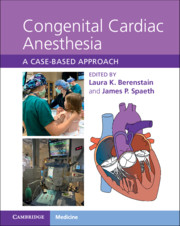Book contents
- Congenital Cardiac Anesthesia
- Congenital Cardiac Anesthesia
- Copyright page
- Dedication
- Contents
- Contributors
- Introduction
- Chapter 1 A Congenital Heart Disease Primer
- Section 1 Left-to-Right Shunts
- Section 2 Right-Sided Obstructive Lesions
- Section 3 Left-Sided Obstructive Lesions
- Section 4 Complex Mixing Lesions
- Section 5 Single-Ventricle Physiology
- Section 6 Heart Failure, Mechanical Circulatory Support, and Transplantation
- Section 7 Miscellaneous Lesions and Syndromes
- Chapter 40 Idiopathic Pulmonary Hypertension
- Chapter 41 Pulmonary Hypertension and Congenital Heart Disease
- Chapter 42 Pulmonary Hypertension and Prematurity
- Chapter 43 Pulmonary Hypertension and Moyamoya Disease
- Chapter 44 Vascular Ring
- Chapter 45 Pericardial Effusion
- Chapter 46 Kawasaki Disease
- Chapter 47 VACTERL Syndrome
- Chapter 48 Hurler Syndrome
- Chapter 49 Long QT Syndrome
- Chapter 50 Marfan Syndrome
- Index
- References
Chapter 47 - VACTERL Syndrome
from Section 7 - Miscellaneous Lesions and Syndromes
Published online by Cambridge University Press: 09 September 2021
- Congenital Cardiac Anesthesia
- Congenital Cardiac Anesthesia
- Copyright page
- Dedication
- Contents
- Contributors
- Introduction
- Chapter 1 A Congenital Heart Disease Primer
- Section 1 Left-to-Right Shunts
- Section 2 Right-Sided Obstructive Lesions
- Section 3 Left-Sided Obstructive Lesions
- Section 4 Complex Mixing Lesions
- Section 5 Single-Ventricle Physiology
- Section 6 Heart Failure, Mechanical Circulatory Support, and Transplantation
- Section 7 Miscellaneous Lesions and Syndromes
- Chapter 40 Idiopathic Pulmonary Hypertension
- Chapter 41 Pulmonary Hypertension and Congenital Heart Disease
- Chapter 42 Pulmonary Hypertension and Prematurity
- Chapter 43 Pulmonary Hypertension and Moyamoya Disease
- Chapter 44 Vascular Ring
- Chapter 45 Pericardial Effusion
- Chapter 46 Kawasaki Disease
- Chapter 47 VACTERL Syndrome
- Chapter 48 Hurler Syndrome
- Chapter 49 Long QT Syndrome
- Chapter 50 Marfan Syndrome
- Index
- References
Summary
The acronym Vertebral abnormalities, Anal atresia, Tracheo-esophageal fistula with Esophageal atresia, Radial and Renal dysplasia was described in 1973 and later updated to VACTERL with the inclusion of Cardiac anomalies and Limb defects rather than radial anomalies. The most commonly associated cardiac anomalies are ventricular septal defects, and tetralogy of Fallot (TOF), but a variety of simple and complex cardiac defects are possible. Patients with VACTERL association frequently require surgery for anal atresia or repair of esophageal atresia/tracheoesophageal fistula in the first days of life. Patients with congenital heart disease have significantly more complications, including difficulties with ventilation and oxygenation, need for inotropic therapy, longer duration of mechanical ventilation, and longer intensive care and hospital stays. Patients with ductal-dependent cardiac lesions are an even higher risk group. The perioperative management of a premature infant with unrepaired TOF for repair of esophageal atresia and tracheoesophageal fistula is discussed in this chapter.
- Type
- Chapter
- Information
- Congenital Cardiac AnesthesiaA Case-based Approach, pp. 359 - 366Publisher: Cambridge University PressPrint publication year: 2021

